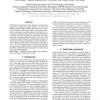Free Online Productivity Tools
i2Speak
i2Symbol
i2OCR
iTex2Img
iWeb2Print
iWeb2Shot
i2Type
iPdf2Split
iPdf2Merge
i2Bopomofo
i2Arabic
i2Style
i2Image
i2PDF
iLatex2Rtf
Sci2ools
INTERSPEECH
2010
2010
A comparative large scale study of MLP features for Mandarin ASR
MLP based front-ends have shown significant complementary properties to conventional spectral features. As part of the DARPA GALE program, different MLP features were developed for Mandarin ASR. In this paper, all the proposed frontends are compared in systematic manner and we extensively investigate the scalability of these features in terms of the amount of training data (from 100 hours to 1600 hours) and system complexity (maximum likelihood training, SAT, lattice level combination, and discriminative training). Results on 5 hours of evaluation data from the GALE project reveal that the MLP features consistently produce relative improvements in the range of 15% - 23% at the different steps of a multipass system when compared to the conventional short-term spectral based features like MFCC and PLP. The largest improvement is obtained using a hierarchical MLP approach.
Conventional Spectral Features | Hierarchical Mlp Approach | INTERSPEECH 2010 | MLP Based Front-ends | Signal Processing |
| Added | 18 May 2011 |
| Updated | 18 May 2011 |
| Type | Journal |
| Year | 2010 |
| Where | INTERSPEECH |
| Authors | Fabio Valente, Mathew Magimai-Doss, Christian Plahl, Suman V. Ravuri, Wen Wang |
Comments (0)

